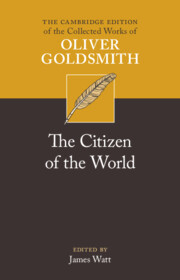185 results

The Citizen of the World
- Coming soon
-
- Expected online publication date:
- October 2024
- Print publication:
- 31 October 2024
-
- Book
- Export citation
General Editors’ Preface
-
- Book:
- The Prefaces
- Published online:
- 08 March 2024
- Print publication:
- 28 March 2024, pp xv-xxi
-
- Chapter
- Export citation
Acknowledgments
-
- Book:
- The Prefaces
- Published online:
- 08 March 2024
- Print publication:
- 28 March 2024, pp ix-x
-
- Chapter
- Export citation
Textual Variants
-
- Book:
- The Prefaces
- Published online:
- 08 March 2024
- Print publication:
- 28 March 2024, pp 591-596
-
- Chapter
- Export citation
Bibliography
-
- Book:
- The Prefaces
- Published online:
- 08 March 2024
- Print publication:
- 28 March 2024, pp clxix-cxciv
-
- Chapter
- Export citation
List of Illustrations
-
- Book:
- The Prefaces
- Published online:
- 08 March 2024
- Print publication:
- 28 March 2024, pp viii-viii
-
- Chapter
- Export citation
Emendations
-
- Book:
- The Prefaces
- Published online:
- 08 March 2024
- Print publication:
- 28 March 2024, pp 597-597
-
- Chapter
- Export citation
Contents
-
- Book:
- The Prefaces
- Published online:
- 08 March 2024
- Print publication:
- 28 March 2024, pp vii-vii
-
- Chapter
- Export citation
List of Abbreviations
-
- Book:
- The Prefaces
- Published online:
- 08 March 2024
- Print publication:
- 28 March 2024, pp xi-xiv
-
- Chapter
- Export citation
The Prefaces
-
- Book:
- The Prefaces
- Published online:
- 08 March 2024
- Print publication:
- 28 March 2024, pp 1-277
-
- Chapter
- Export citation
Chronology of Composition and Production
-
- Book:
- The Prefaces
- Published online:
- 08 March 2024
- Print publication:
- 28 March 2024, pp clvi-clxviii
-
- Chapter
- Export citation
Introduction
-
- Book:
- The Prefaces
- Published online:
- 08 March 2024
- Print publication:
- 28 March 2024, pp xxix-cxlviii
-
- Chapter
- Export citation
General Chronology of James’s Life and Writings
-
- Book:
- The Prefaces
- Published online:
- 08 March 2024
- Print publication:
- 28 March 2024, pp xxii-xxviii
-
- Chapter
- Export citation
Textual Introduction
-
- Book:
- The Prefaces
- Published online:
- 08 March 2024
- Print publication:
- 28 March 2024, pp cxlix-clv
-
- Chapter
- Export citation
Notes
-
- Book:
- The Prefaces
- Published online:
- 08 March 2024
- Print publication:
- 28 March 2024, pp 280-590
-
- Chapter
- Export citation
Glossary of Foreign Words and Phrases
-
- Book:
- The Prefaces
- Published online:
- 08 March 2024
- Print publication:
- 28 March 2024, pp 278-279
-
- Chapter
- Export citation
Index
-
- Book:
- The Prefaces
- Published online:
- 08 March 2024
- Print publication:
- 28 March 2024, pp 598-636
-
- Chapter
- Export citation
Frontmatter
-
- Book:
- The Prefaces
- Published online:
- 08 March 2024
- Print publication:
- 28 March 2024, pp i-vi
-
- Chapter
- Export citation
Head and Neck Cancer: United Kingdom National Multidisciplinary Guidelines, Sixth Edition
-
- Journal:
- The Journal of Laryngology & Otology / Volume 138 / Issue S1 / April 2024
- Published online by Cambridge University Press:
- 14 March 2024, pp. S1-S224
- Print publication:
- April 2024
-
- Article
-
- You have access
- Open access
- HTML
- Export citation

The Prefaces
-
- Published online:
- 08 March 2024
- Print publication:
- 28 March 2024

